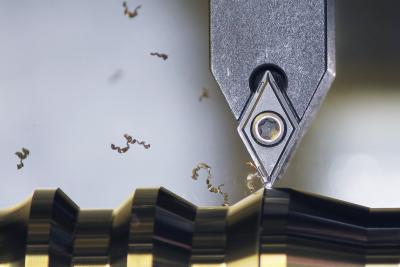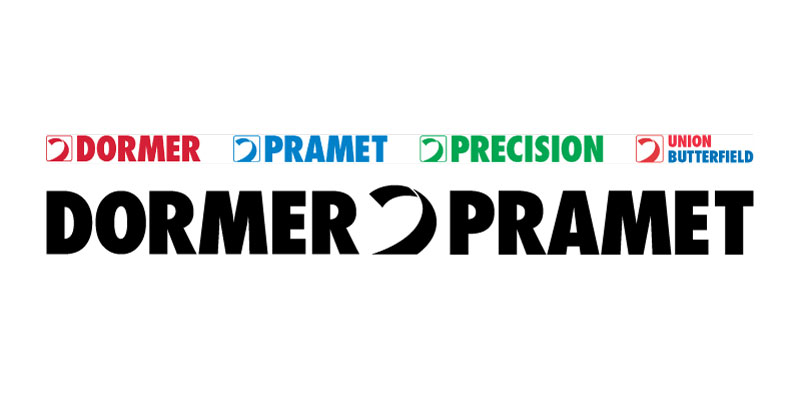
Dormer Pramet launches new Pramet chipbreakers and grades. The NF1 and NF2 positive chipbreakers support turning applications in stainless steel while the FF2, FM2 and RM3 chipbreakers support steel and cast iron. The SF2 and SF3 positive inserts are first choice for S-group materials and high-performance alloys.
The NF1 is a universal chipbreaker for fine finishing to medium machining, peripherally ground to impart a fine surface finish. The versatile NF2 chipbreaker incorporates a small stabilizing T-Land and covers a range of applications from semifinishing to light roughing.
The FF2 chipbreaker has a positive rake angle and depth of cut from 0.01 inch for fine finishing applications in low carbon steels. The FM2 chipbreaker is for finishing to medium machining and features a protective land suitable for continuous and interrupted operations. The highly resistant RM3 chipbreaker is for roughing applications in steels and cast irons and suitable for unfavorable machining conditions.
The SF2 and SF3 positive inserts provide a highly secure and dependable option for turning applications for S-group materials and high-performance alloys. The SF2 chipbreaker is for fine turning at the lowest possible feeds while the SF3 chipbreaker, with its positive inclined cutting edge, supports finishing operations. Especially effective when used on small and slender components, both inserts offer a sharp cutting edge with minimal radius. This promotes low cutting forces which, in turn, prevents work hardening and ensures a high quality surface finish.
Finishing off this new Pramet offering is the T7325 grade for productive machining of stainless steels. It has been developed to complement the existing T7335 grade, which is recommended for use in unstable machining environments. Suitable for interrupted cutting, the latest T7325 grade features a functional gradient substrate and special MT-CVD coating. This combination offers high cutting strength, reduced built-up edge and resistance to the formation of cracks. As a result, the grade provides a high level of operational reliability, performance and tool life.
Contact Details
Related Glossary Terms
- alloys
alloys
Substances having metallic properties and being composed of two or more chemical elements of which at least one is a metal.
- built-up edge ( BUE)
built-up edge ( BUE)
1. Permanently damaging a metal by heating to cause either incipient melting or intergranular oxidation. 2. In grinding, getting the workpiece hot enough to cause discoloration or to change the microstructure by tempering or hardening.
- carbon steels
carbon steels
Known as unalloyed steels and plain carbon steels. Contains, in addition to iron and carbon, manganese, phosphorus and sulfur. Characterized as low carbon, medium carbon, high carbon and free machining.
- cast irons
cast irons
Cast ferrous alloys containing carbon in excess of solubility in austenite that exists in the alloy at the eutectic temperature. Cast irons include gray cast iron, white cast iron, malleable cast iron and ductile, or nodular, cast iron. The word “cast” is often left out.
- chipbreaker
chipbreaker
Groove or other tool geometry that breaks chips into small fragments as they come off the workpiece. Designed to prevent chips from becoming so long that they are difficult to control, catch in turning parts and cause safety problems.
- depth of cut
depth of cut
Distance between the bottom of the cut and the uncut surface of the workpiece, measured in a direction at right angles to the machined surface of the workpiece.
- hardening
hardening
Process of increasing the surface hardness of a part. It is accomplished by heating a piece of steel to a temperature within or above its critical range and then cooling (or quenching) it rapidly. In any heat-treatment operation, the rate of heating is important. Heat flows from the exterior to the interior of steel at a definite rate. If the steel is heated too quickly, the outside becomes hotter than the inside and the desired uniform structure cannot be obtained. If a piece is irregular in shape, a slow heating rate is essential to prevent warping and cracking. The heavier the section, the longer the heating time must be to achieve uniform results. Even after the correct temperature has been reached, the piece should be held at the temperature for a sufficient period of time to permit its thickest section to attain a uniform temperature. See workhardening.
- land
land
Part of the tool body that remains after the flutes are cut.
- rake
rake
Angle of inclination between the face of the cutting tool and the workpiece. If the face of the tool lies in a plane through the axis of the workpiece, the tool is said to have a neutral, or zero, rake. If the inclination of the tool face makes the cutting edge more acute than when the rake angle is zero, the rake is positive. If the inclination of the tool face makes the cutting edge less acute or more blunt than when the rake angle is zero, the rake is negative.
- stainless steels
stainless steels
Stainless steels possess high strength, heat resistance, excellent workability and erosion resistance. Four general classes have been developed to cover a range of mechanical and physical properties for particular applications. The four classes are: the austenitic types of the chromium-nickel-manganese 200 series and the chromium-nickel 300 series; the martensitic types of the chromium, hardenable 400 series; the chromium, nonhardenable 400-series ferritic types; and the precipitation-hardening type of chromium-nickel alloys with additional elements that are hardenable by solution treating and aging.
- turning
turning
Workpiece is held in a chuck, mounted on a face plate or secured between centers and rotated while a cutting tool, normally a single-point tool, is fed into it along its periphery or across its end or face. Takes the form of straight turning (cutting along the periphery of the workpiece); taper turning (creating a taper); step turning (turning different-size diameters on the same work); chamfering (beveling an edge or shoulder); facing (cutting on an end); turning threads (usually external but can be internal); roughing (high-volume metal removal); and finishing (final light cuts). Performed on lathes, turning centers, chucking machines, automatic screw machines and similar machines.

